Spiraea cudidaghense:a new species from south-eastern Anatolia,Turkey
Mehmet Fırat •Necmi Aksoy
Abstract A new species,Spiraea cudidaghense(sect.Spiraeoideae,Rosaceae),is described and illustrated with diagnostic characters and taxonomic comments.Its characteristics are compared with those of the type species from which it differs mainly in compound corymbs in florescence,ovate-obovate leaves,white petals,glabrous branches and densely pilose corymbs.In addition,a map of the geographic distribution of the new species,an IUCN ranking and noteson taxonomic affinities are also provided.
Keywords Spiraea cudidaghense·Taxonomy·New species·Turkey
Introduction
The genus Spiraea L.consists of 138 species of shrubs mainly of temperate eastern Asian distribution(The Plant List 2013).Two species of the genus Spiraea(Rosaceae)Spiraeoideae Agardh have recently been reported in the Flora of Turkey and belong to Sect.Chamaedryon Seringe(Browicz 1972).
In addition,specimens of Spiraea brahuica Boissier and S.pilosa Franchet in South West Asia,a region adjacent to Turkey,have been noted by Pojarkova(1939)and Browicz(1984).Recently,Zare(2002)reported S.shekeii from northern Iran.However,certain sights exist in the treatment of this taxonomically critical genus in the Flora of Turkey.
As a result of a field study on plants collected from southern Turkey,a Spiraea species appeared to be different from the known species in Turkey;namely,S.crenata L.and S.hypericifolia L.(Browicz 1972).Further studies revealed that the plant is a new species in Turkey.
Materials and methods
The new species was collected by the senior author(M.Fırat)in October 2013 and July 2014 in the Cudi Mountains Province(S¸ırnak),in the south eastern Anatolia region while doing the flora fieldwork of the area.A total of 10 herbarium specimens(15 individual plants)of the species were collected from three adjacent localities and deposited in the herbaria of VANF and DUOF.After a careful examination and comparison of the specimens with the type and isotype specimens of Spiraea cudidaghense in VANF and DUOF herbaria,it was realized that the specimens belonged to a new,undescribed species of Spiraeoideae from the Rosaceae family.A substitute name is provided,accompanied by a detailed description and illustration.
According to the grid system used in Flora of Turkey,the species in S¸ırnak province falls within the C9 square(Fig.3),(Davis 1965).The threat category of the species was evaluated according to IUCN Criteria.
Taxonomy
Diagnosis Spiraea cudidaghense Fırat&N.Aksoy,sp.nov.is shown in Figs.1,2,3,4.Spiraea cudidaghense clearly differs from S.pilosa,S.crenata and S.hypericifolia in its stems(40–)45–55(–60)cm tall,glabrous,twigs with slender(to 3 mm),terete,brownish or dark brown,leavesbroadly angular-obovate rhombic orrounded rhombic 3.5–12.9 × 7.0–16.3 mm with glabrous surface,in florescence,compound corymbiform at the end of branches,slender,leafy,0.7–3.8 cm with 5–30 flowers,pedicels villous-tomentose,petals creamy white,orbicular obovate,1–1.6 × 1.4–3 mm.
Typus Turkey.C9S¸ırnak:CudiMountains,Bılgan region,rocky slopes,969 m,37°25′11′N,42°38′57′E,15 October 2013,M.Fırat 30467(holotype DUOF!,isotypes ISTO!,VANF!).Description Shrub is up to(40–)45–55(–60)cm tall,glabrous,with slender,straight,terete branches;long shoots and branchlets conspicuously slender,terete,entirely glabrous,brownish in current year,dark brown in age;initially smooth,cracking later,and peeling into longitudinal strips in the second year,sterile long shoots of the present year(fully developed only from July)to ca.(3.5–)4–15(–18)cm,buds small,usually shorter or equal to half of petiole,with several scales sparsely pilose especially along margin.Leaves are deep green adaxially,conspicuously green areolate abaxially,with margin somewhat thickened, flattened,venation reticulate,deep green,contrasting abaxially,in principal veins distinct adaxially;leaf blades,as reduced in basal part of sterile long shoots,often slightly longer than wide,broadly obovate and narrowly cuneate;leaf blades fully developed in middle and apical portions of shoots,unequal in shape and size;blades on sterile long shoots more variable,broadly angular-obovate rhombic and broadly obovate to transversally rounded rhombic,(3.6–)5.1–11.2 (12.9)× (7.02–)9.36–15.15(16.25)mm,excluding petiole;irregularly shallowly and orbicular 3 or 4 lobed or only crenate to almost entire,middle lobe truncate,obtuse or mucronate,lateral lobes similar,but with the apical tooth often apiculate pointed;glabrous on both surfaces,3 or 4 pairs of decreasing,incised,truncate,obtuse or mucronate,acute teeth in upper half on sterile long shoots or usually with only 2 or 3 tooth pairs in upper third of narrower leaves on short fertile branchlets or in lower part of sterile long shoots;lower pair of largest teeth in broader leaves often in the form of indistinct lateral lobes with 1 to 3(–4)outer,minute,crenate teeth;apex of blade acute,truncate,obtuse or mucronate,venation consisting of 3–4 principal veins branching at one point at the triangular basal connection to petiole;petioles 3.07–3.92 mm,In florescence compound corymbiform at the end of branches,slender,leafy,(0.7–)1.5–2.85(–3.8)cm,villous-tomentose branchlets,with(5–)7 to 25(–30) flowers,each always singly on slender,villous,(0.6)1.5–2.5 mm pedicel,long bracteate above the middle;bract 2.1–3.5(–4)mm elliptic.Hypanthium and sepals are villous on both surfaces;hypanthium is shallowly funnel-shaped;sepals are triangular with acute apex,0.7–1.46 × 0.31–0.81 mm,equaling the hypanthium;petals, creamy white, orbicular obovate, ca.1–1.6 × 1.4–2.4(–3)mm,entire or± retuse at the margin;stamens ca.20,equaling or±longer than petals,with filaments(1.3–)1.5–1.7(2.5)staminal mm,spreading to re flexed,anther connectives maroon to black,anther generally ivory,tip retuse to emarginate.Follicles erect and are parallel in maturity,0.9–1.5 mm,sparsely hairy only along ventral suture,styles ca.0.6–1.35 mm,dorsal,erectspreading at the apex of follicles.Ovules ca.4,linear.Seeds are 1.1–1.5 mm.
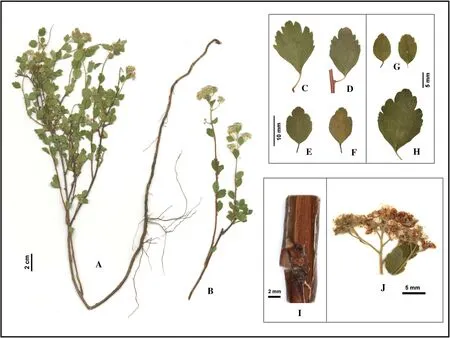
Fig.1 Spiraea cudidaghense:a Fertile 3-year portion of sterile branch with one young long shoot,b Fertile branch with two young long shoots,c leaf from in florescence basal rosette,d abaxial view,e fully developed leaves of sterile long shoots,f abaxial view,g fully developed leaf of sterile long shoot,h adaxial view,i branchlets peeling into longitudinal strips and bud,j in florescence in flowers from July collection,M.Fırat.30467(DUOF),at the type locality
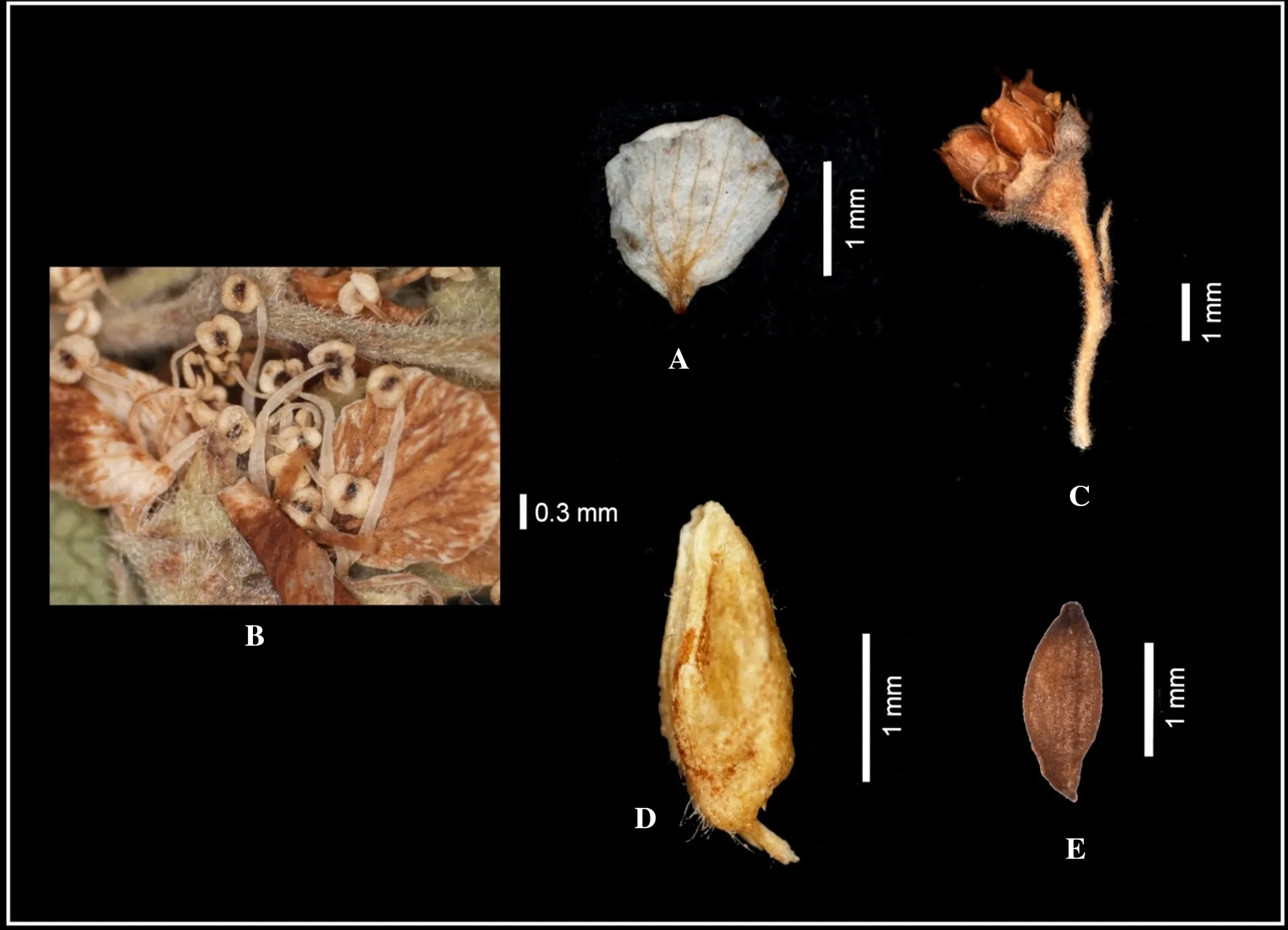
Fig.2 Spiraea cudidaghense:a is petal,b petal and stamen,c pedicel,hypantium,folicules,d folicules ventral suture,e seed from August collection,M.Fırat.30467(DUOF)at the Isotype locality
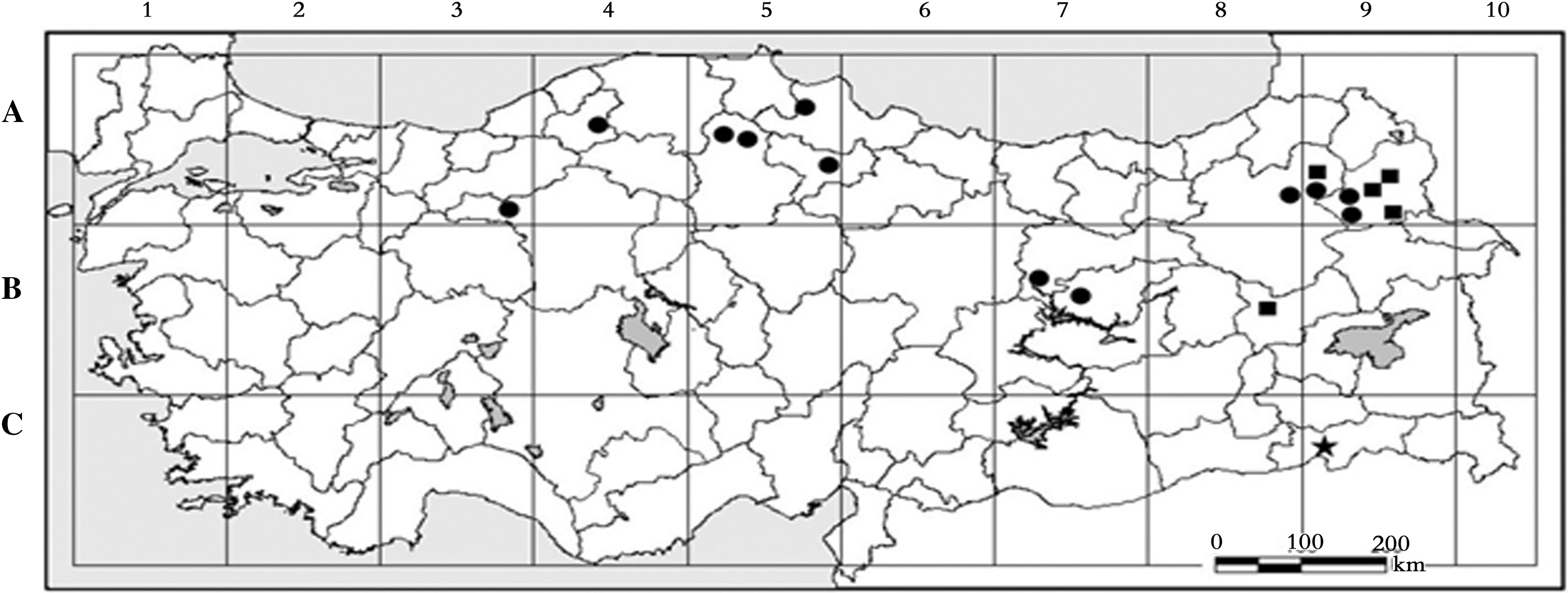
Fig.3 Distribution maps of Spiraea cudidaghense(star),Spiraea hypericifolia(square),Spiraea crenata(circle)in Flora of Turkey(Davis 1972)
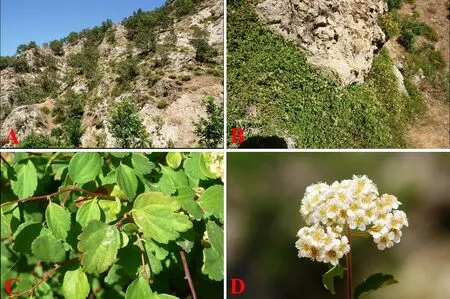
Fig.4 Spiraea cudidaghense;a habitat,b habitus,c fertile branch,d is compound corymbiform;M.Fırat.30467(DUOF)
Phenology Flowers and fruits occur in June and August.
Distribution and ecology
Distribution Spiraea cudidaghense is endemic to Cudi Mountains,S¸ırnak province in south-eastern Anatolia,Turkey,an Irano-Turanian element(Figs.3,4).
Ecology Spiraea cudidaghense is distributed on the Quercus infectoria subsp.boissieri,Pistacia atlantica shrubs vegetation and on rocky slopes at 850–1100 m altitude with Paliurus spina-christi,Hirtellina kurdica,Pulicaria gnaphalodes,Teucrium chasmophyticum,Pentapleura subulifera,Campanula radula,Stachys kurdica,Eupatorium cannabinum,Origanum vulgare subsp.viridulum,Vitis vinifera,Rubus sanctus,Pterocephalus kurdicus,Hypericum triquetrifolium,Platanus orientalis,Dionysia bornmuelleri,Dianthus orientalis,Fraxinus sp.
Conservation status
Endemic to south-eastern Anatolia,an Irano-Turanian.Spiraea cudidaghense is not widespread in S¸ırnak province,known in only two localities:on the stream banks stream of the Gundek and Besta region around Cudi Mountains Province.It appears to be known only from the present locality and its estimated area of occupancy is less than 10 km2(criterion B).The population is unhealthy with less than fifty mature individuals(criterion D).In addition,its extremely restricted area implies a high risk of extinction owing to subjection to grazing and its natural habitat being destroyed by road and dam construction.Therefore,it should be classified as ‘Critically Endangered(CR)‘B1ab(iii)+2ab(iii);D’based on the criteria of the IUCN Red List Categories(IUCN 2001).In order to suggest another IUCN category,more investigation is needed to clearly determine the distribution,population size and threats.
As a result of the floristic investigations,the samples belonging to Spiraea sp.genus were determined as S.cudidaghense,and with this determination its presence in Turkey was proven and the final number of taxa was increased to 3.
Key to the Turkish species of Spiraea
Diagnostic key to S.cudidaghense,S.hypericifolia,S.crenata and S.pilosa:A dichotomous key referring to S.cudidaghense and similar species follows and it should be added to the key of Spiraea as in the Flora of Turkey Browicz,K.(1972)and as an identification key for Spiraea in south western and south Asia:
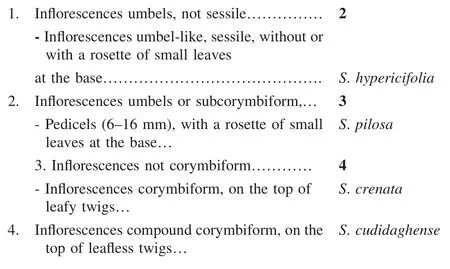
Conclusions
Spiraea cudidaghense is similar to S.pilosa,S.crenata and S.hypericifolia(Table 1).It is well-characterized by a compound corymbifom in florescence, ovate-obovate leaves,white petals,glabrous branches and densely pilose corymbs.It differs from S.pilosa,S.crenata and S.hypericifolia in the following characters:height up to 40–60 cm,glabrous,with slender,straight,terete branches;long shoots and branchlets glabrous,brownish in current year,dark brown with age;initially smooth,cracking later and peeling into longitudinal strips in the second year,sterile long shoots of the present year.Leaves broadly obovate and narrowly cuneate;blades on sterile long shoots more variable,broadly angular-obovate rhombic and broadly obovate to transversally rounded rhombic,3.5–12.9 × 7.0–16.3 mm, irregularly shallowly and orbicularly 3 or 4 lobed or only crenate to almost entire,middle lobe truncate,obtuse or mucronate,lateral lobes similar,but with the apical tooth often apiculate pointed;glabrous on both surfaces.In florescence compound corymbiform at the end of branches,slender,leafy,0.7–3.8 cm,villous-tomentose branchlets,with 5–30 flowers, each always singly on slender, villous,0.6–2.5 mm pedicel,long bracteate above the middle;bract 2.1–4 mm elliptic.Hypanthium and sepals villous on both surfaces;hypanthium shallowly funnel-shaped,sepals triangular with acute apex,petals,creamy white,orbicular obovate,ca.1–1.6 × 1.4–3 mm.Follicles erect and parallel in maturity,0.9–1.5 mm,sparsely hairy only along ventral suture,styles ca.0.6–1.35 mm,dorsal,erectspreading at the apex of follicles.
Moreover this new species differs from all congeners by having clearly branched corymbs(compound corymbs are not umbelliform or nearly simple).The species,due to its corymbus,might show some similarities to S.pilosa and S.shekeii but differs from both mainly in triangular sepals with acute apices and long stamens(not recurved sepals,petals,creamy white,orbicular obovate and stamens equaling or±longer than petals,spreading to re flexed,anther connectives maroon to black).It is clearly shown and understood the floristic links between south eastern Turkey,northern Iran and central Asia with the distribution of this new species,S.cudidaghense.
Spiraea species are important ornamental shrubs for gardening and landscape design.Spiraea cudidaghense issuitable for use as an ornamental in rock gardens,in small gardens,and on road slopes.

Table 1 Some characteristics of Spiraea cudidaghense,S.pilosa,S.crenata and S.hypericifolia
Additional specimens examined
Paratype Spiraea cudidaghense—Turkey:C9 S¸ırnak:Silopi,Cudi Mountains,Besta region,rocky slopes,1042 m,37°21′N,42°32′E,8 July 2014,M.Fırat 31055(VANF!,DUOF!).
Specimens examined Spiraea pilosa—Afghanistan,Kurramvalley, J.E.T, Aitchison, 09.06.1879 (det.E.Schönbeck-Temsey,1967),(K000737451!),Afghanistan:Kabol,Tang-i-Gharu,upper part,steep slopes among rocks,I.C.Hedge,&P.Wendelbo,W 2805,27 April 1962(E00406713!),Afghanistan:Kabol,In faucibusTang-i Gharu inter Kabul,34°30′N,69°10′E,et Sarobi,34°40′N,69°46′E,K.H.Rechinger34378,12 May 1967,(E00406712!).Spiraea crenata—Turkey:A5C¸orum:before Hacıhamza Village,600 m,Limestone Mts.White see.,Tobey 2439,May 11 1969(ISTO 9987),Turkey:A3 Bolu:Seben Karakiris¸Mountain,C¸al Hil.,Rocky Are,1350 m,N.Aksoy 1506,30.05.1999(ISTO 27750),Turkey:A9 Kars:Kars Göle,Karınca Plane Area,B.Telli,Jully 1965,Det:F.Yaltirik(ISTO 7978).Spiraea hypericifolia—Turkey:A9 Kars Mountains,East of Kağızman,8 km from Akc¸ay to Cumacay,1650 m,Spireae shrubland,dominant hillsides 1–2 m,Davis 46804,17 July 1966,(ISTO 10039),Turkey:C4 Konya:Ermenek,C¸amlıca,1500 m,H.Belen,July 1988,Det.F.Yaltirık&A.Efe,1990(ISTO 26800).Turkey:A9 Kars:Kağızman,in the beetwen Akc¸ay-Cumac¸ay,at 8 km,1650 m,Davis 46804,17 July 1966(ISTO 5247).Turkey:A9 Kars:Kağızman,from Akc¸ay to Cumac¸ay 8–10 km,1425 m,40°06′01′N,43°16′53′E,M.Fırat 30669,29 April 2014(VANF).
Etymology and vernacular name
The species epithet is derived from the name of the Cudi Dağı province where this species was collected.In S¸ırnak province,indigenous people use the name ‘Mecrîsok’for Spiraea sp.(Fırat 2013).
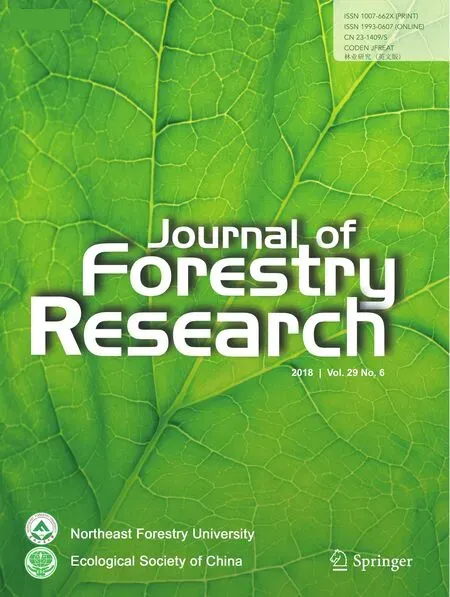 Journal of Forestry Research2018年6期
Journal of Forestry Research2018年6期
- Journal of Forestry Research的其它文章
- Black locust(Robinia pseudoacacia L.)as a multi-purpose tree species in Hungary and Romania:a review
- The impact of the environmental factors on the photosynthetic activity of common pine(Pinus sylvestris)in spring and in autumn in the region of Eastern Siberia
- Osmoregulators in Hymenaea courbaril and Hymenaea stigonocarpa under water stress and rehydration
- Effect of nitrogen levels on photosynthetic parameters,morphological and chemical characters of saplings and trees in a temperate forest
- Free amino acid content in trunk,branches and branchlets of Araucaria angustifolia(Araucariaceae)
- Exogenous application of succinic acid enhances tolerance of Larix olgensis seedling to lead stress
